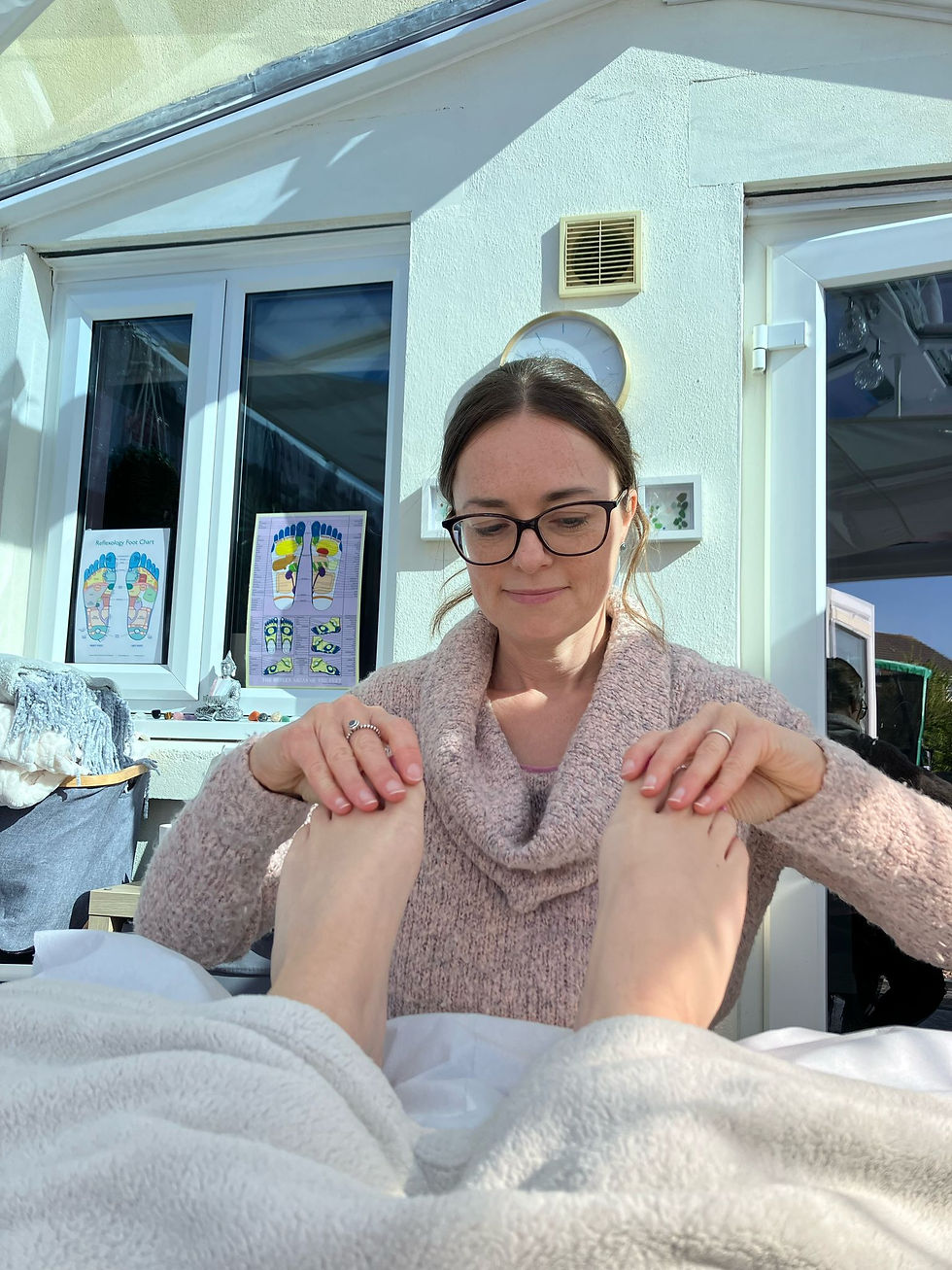Reflexology to Support Women's Health:
- Lynsey Gallimore

- Sep 26
- 3 min read

Introduction
Reflexology can be used as a holistic therapy to help improve women's health. As we transition through each phase from puberty, menstruation, peri-menopause and menopause we all have our own unique journey and different experiences or symptoms. Support is available by using reflexology as a tool to help you connect with your body as you go through the physical and emotional stages of life. Specific reflexology techniques can be used to calm and balance the endocrine, nervous and lymphatic system, balance hormones and reduce stress, low mood and anxiety. This can be used alongside any other conventional medical treatment and is not suggesting you use reflexology as a replacement. Reflexology is a holistic and person centered therapy where a bespoke session can be tailored to you. Other lifestyle advise such as nutrition, meditation, yoga practice , massage, reiki may also compliment your sessions and ease some of the symptoms or experiences you may be feeling.
The Role of Reflexology in Managing Hormones:
Reflexology is a therapeutic practice that involves applying pressure to specific reflex points on the feet, hands, or ears. These points correspond to various organs, glands, and systems in the body, including those responsible for hormone production. By stimulating these points, reflexology is believed to help restore balance, promote relaxation, and support the body’s natural healing processes.
Hormones are secreted by glands such as the pituitary, thyroid, adrenal glands, and ovaries. Reflexology practitioners apply pressure to reflex points linked to these glands, aiming to enhance circulation, reduce blockages, and encourage optimal glandular function. For example:
Pituitary reflex point (center of the big toe) is considered the “master gland,” influencing many hormonal processes.
Thyroid reflex point (base of the big toe) supports metabolism and energy regulation.
Adrenal reflex point (above the arch of the foot) helps regulate stress responses.
Ovary reflex points (outer edge of each heel) play a role in reproductive hormone balance.
Chronic stress disrupts hormonal balance by overstimulating the adrenal glands, leading to excessive cortisol production. This can contribute to fatigue, irregular cycles, weight gain, and mood swings. Reflexology promotes deep relaxation by calming the nervous system, which may help lower stress hormone levels and allow the body to return to balance.
Reflexology and the Menstrual Cycle:
Phases of the Menstrual Cycle- typically has four phases:
Menstrual phase – Shedding of the uterine lining (days 1–5).
Follicular phase – Follicle development and estrogen rise (days 1–13).
Ovulation phase – Release of an egg, peak in luteinizing hormone (around day 14).
Luteal phase – Progesterone increases to prepare for possible pregnancy (days 15–28).
Reflexology for Menstrual Symptoms:
Reducing cramps: Applying pressure to reflex points for the uterus and ovaries, along with the solar plexus point, may ease muscle tension and improve circulation.
Balancing mood: Stimulating adrenal and pituitary points can help regulate stress hormones, supporting emotional stability.
Regulating cycles: Consistent reflexology sessions may help balance endocrine function, potentially improving irregular cycles.
Reflexology During Peri-Menopause:
Peri-menopause is the transitional stage before menopause, typically beginning in a woman’s 40s, marked by fluctuating hormone levels. Symptoms may include hot flashes, irregular cycles, sleep issues, and mood swings.
Reflexology for Peri-Menopause Support:
Hot flashes: Working on the pituitary, thyroid, and adrenal reflexes may help regulate temperature fluctuations.
Sleep disturbances: Stimulating the solar plexus and adrenal reflex points can promote relaxation and reduce insomnia.
Emotional fluctuations: Reflexology for the pituitary, adrenal, and brain reflexes may help stabilize mood and ease anxiety.
Reflexology and Menopause:
Menopause is officially diagnosed after 12 consecutive months without menstruation, usually occurring between ages 45–55. Common symptoms include hot flashes, joint pain, mood swings, and weight changes.
Reflexology for Menopausal Symptoms:
Joint pain: Reflex points for the spine, hips, and joints can improve circulation and reduce stiffness.
Mood swings: Targeting the pituitary and adrenal reflexes can support hormonal regulation and emotional stability.
Weight management: Reflexology that stimulates the thyroid and digestive system reflexes may support metabolism and healthy weight balance.
Conclusion
Reflexology offers a gentle, non-invasive approach to supporting women through the many hormonal changes of their lives. By targeting specific reflex points linked to the endocrine system, reflexology may help reduce stress, ease menstrual discomfort, support peri-menopausal transitions, and improve menopausal well-being.
While reflexology can be a valuable complementary therapy, it should not replace medical treatment. Women are encouraged to consult healthcare professionals before beginning Reflexology or any new therapy, ensuring a holistic and safe approach to their hormonal health.
Lynsey x









Comments